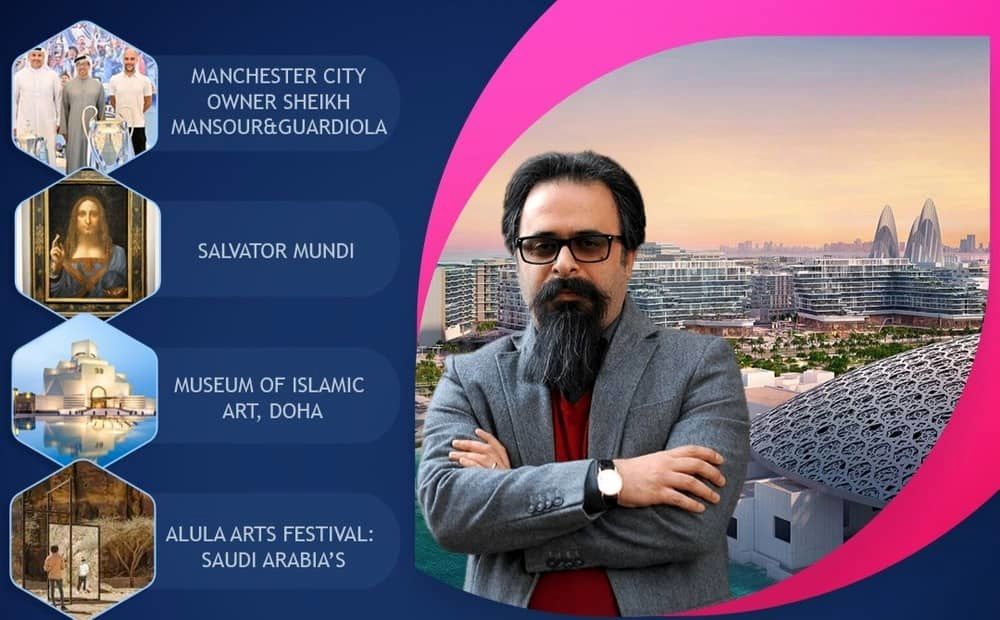Hossein Hashempoor
Hossein Hashempoor: Middle Eastern Modernization Through Football and Arts - United Effort of Saudi Arabia and UAE Being Watched by Whole Globe

By providing various examples from the contemporary Middle East, Hossein Hashempoor, the editor-in-chief of the Iran Art website, argues that by showcasing both art and football, the world is given a good message.
Iran Art: The Middle East has recently wowed the entire world. Once upon a time, the Middle East was associated with oil and the unrestricted use of energy, but now, with the change in mindset of various nations, is reintroducing itself to the world as a rising powerhouse.
This unprecedented display of power appears to be accompanied by a football and art presentation, making a modern statement about how the best medium for branding and compelling advertising is both art and, of course, football in the modern world. It is apparent that Saudi Arabia and the UAE are supporting this same strategy in our region.
1:
This issue places Saudi Arabia at the top of the global headlines, from Ronaldo, Benzema, and N'Golo Kanté to the Al Ula arts festival and the development of a Georges Pompidou Museum branch (which will open in 2028).
Manchester City FC, the current European champion football team coached by the renowned Pep Guardiola, and the renaming of Manchester City Stadium to Etihad (Emirates Airways) are two examples of how Emirates won over the entire world. The British club is presided over by the UAE royalist politician Mansour bin Zayed Al Nahyan.
The recent managing of Expo Dubai and the recent renaming of the Arsenal football team's stadium in London to Emirates are both outstanding instances of how to put together a successful puzzle.
At the same time, since 2006, the UAE has grown to be the center of the region's art economy. International auction houses were set up in Dubai, the highly successful 16-year-old Art Fair launched, Alserkal Avenue was created, a branch of the Louvre paved in Abu Dhabi in 2017, the Guggenheim Museum in Abu Dhabi (which will open in 2025), the Sharjah Biennial, the Abu Dhabi Art Fair, etc. are only a few instances of the UAE's ambitious arts programs.
2:
But five years ago, the art world was mesmerized by the incredible collaboration between Saudi Arabia and the United Arab Emirates, which demonstrated their understanding of the present condition of the art market: the acquisition of the most expensive painting while the debate over its authenticity went unnoticed: the controversial Salvator Mundi!
Salvator Mundi, a piece of art attributed to Leonardo da Vinci, sold for $450 million at the Christie's New York auction in 2017, which made it the most expensive painting in history.
Although Christie's listed this piece as one of da Vinci's original artwork, many people regarded it to be the product of collaboration between the master artist and his pupils, posing major questions about the legitimacy of the piece.
When Saudi Arabia's Minister of Culture, Prince Badr bin Abdullah, purchased this artwork and exhibited it at the Louvre Museum in Abu Dhabi, it highlighted the meticulous planning done in the Middle East to win over the public and draw in art tourists. They are aware that acquiring the most costly item on the art market will put you in a spot where you will often have to wait for years.
3:
Of course, Qatar, which shone with the World Cup, had previously stood out with the presence of Barcelona's Xavi, and before that with the establishment of the Museum of Islamic Art (MIA) in 2008 and the purchase of several hundred million works of art, including a Paul Gauguin painting, in 2019 with a price of $300 million; And the establishment of the Mathaf: Arab Museum of Modern Art.
Doha is now quickly becoming into an art center because to the Qatar Foundation, which was formed in 1995 by Sheikh Hamad bin Khalifa Al Thani, the Emir of Qatar, and his wife Moza bint Nasser. It's interesting to recall that on December 10, 2010, Barcelona Football Club declared that it had achieved a record shirt sponsorship deal with the Qatar Foundation worth 30 million euros a season through to the end of the 2015-16. In a bid to restore our faith in the power of football and art to reshape the Middle Eastern social fabric, this marked the end of the Barcelona club's longstanding history of refusing to take sponsors for the club's shirts.
Additionally, all indicators point to Oman's significant advancement in the fields of art and tourism, and it's likely that we'll hear more news in this area shortly.
Theorists suggest that whereas football generates enormous amounts of immediate social excitement and commerce, art contributes to a civilization's longevity, even for future generations. It is critical that the contemporary Middle East expand its wings.

